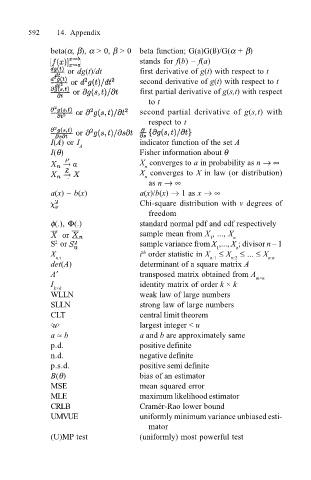Page 615 - Probability and Statistical Inference
P. 615
592 14. Appendix
beta(α, β), α > 0, β > 0 beta function; G(a)G(ß)/G(α + β)
stands for f(b) f(a)
or dg(t)/dt first derivative of g(t) with respect to t
second derivative of g(t) with respect to t
first partial derivative of g(s,t) with respect
to t
second partial derivative of g(s,t) with
respect to t
I(A) or I A indicator function of the set A
I(θ) Fisher information about θ
X converges to a in probability as n → ∞
n
X converges to X in law (or distribution)
n
as n → ∞
a(x) ~ b(x) a(x)/b(x) → 1 as x → ∞
Chi-square distribution with v degrees of
freedom
φ(.), Φ(.) standard normal pdf and cdf respectively
sample mean from X , ..., X n
1
2
S or sample variance from X ,..., X ; divisor n 1
1
n
th
X n:i i order statistic in X ≤ X ≤ ... ≤ X n:n
n:1
n:2
det(A) determinant of a square matrix A
A′ transposed matrix obtained from A m×n
I k×k identity matrix of order k × k
WLLN weak law of large numbers
SLLN strong law of large numbers
CLT central limit theorem
<u> largest integer < u
a ≈ b a and b are approximately same
p.d. positive definite
n.d. negative definite
p.s.d. positive semi definite
B(θ) bias of an estimator
MSE mean squared error
MLE maximum likelihood estimator
CRLB Cramér-Rao lower bound
UMVUE uniformly minimum variance unbiased esti-
mator
(U)MP test (uniformly) most powerful test

